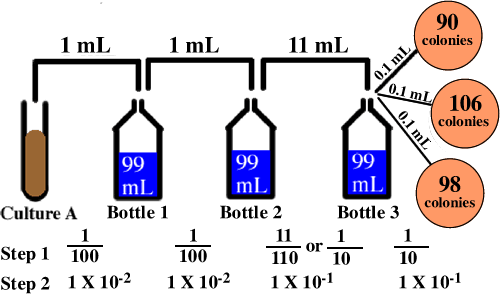THE VIRTUAL EDGE: Lab 5 Cultivation of Bacteria I |
|
Dilution:METHOD 2: This method uses more of a pictorial approach. The first step of this method is to write each dilution as a fraction with the volume transferred out of the more concentrated solution over the total volume of the less concentrated solution. In the final transfer, 0.1 mL is transferred out of the more concentration solution and put directly on the plate. This is a 1/10 dilution.
In the second step of this method, the fractions are converted to scientific notation:
In step 3, the product of the individual dilution factors is calculated to give the final dilution factor: Step 3: 1 X 10-2 * 1 X 10-2 * 1 X 10-1 * 1 X 10-1 = 1 X 10-6 (final dilution factor) In microbiology, the reciprocal of the final dilution factor is called the plating factor. In step 4, the plating factor is calculated. Step 4: plating factor (p.f.) = 1/(1 X 10-6)
Finally, to determine the concentration of culture A, the average number of colonies (as calculated in method 1) is multiplied by the plating factor: Step 5: p. f. * average # of colonies = titer of original culture
**As can be seen, this is the same number that was determined using method 1!** Please feel free to use either method 1 or 2. Method 1 is more concise and more clearly tracks units. Unfortunately, in microbiology method 2 is commonly used and even if you select method 1 it will be necessary to be familiar with the plating factor term. * Significant figures: The greatest number of significant figures that can be known is three, as it is impossible to count halves of colonies. However, less than three significant figures may be retained depending on the number of colonies and the accuracy of the measuring devices selected. |
|
| Lab 5 / Aseptic Technique / Nutritional Requirements for the Cultivation of Bacteria / Enumeration of Bacteria / Dilutions / Lab 5 Organisms Please take a few minutes to fill out a brief survey about your experience using the Virtual Edge: https://docs.google.com/forms/d/1yGbkF0KM92WBSk-IgS-EkjxkTKTQwhzuXmDsVpwRDoU/viewform Please email comments/problems to cboggs@uwyo.edu |
|
Rachel Watson, M.S. |
|

The Virtual Edge by http://www.uwyo.edu/virtual_edge/ is licensed under a Creative Commons Attribution-Noncommercial-Share Alike 3.0 United States License
